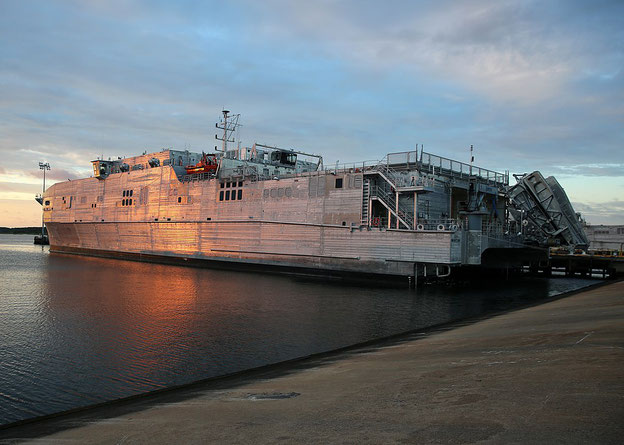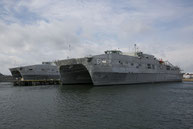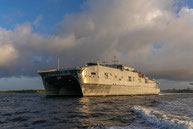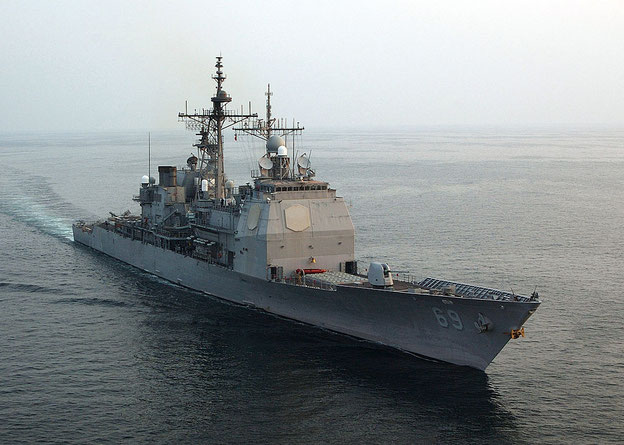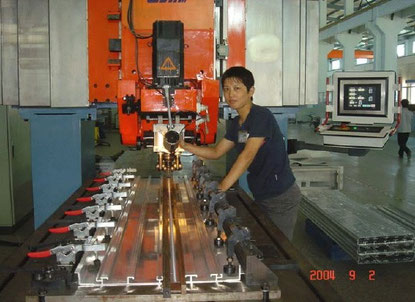Making Aluminium Panels from Aluminium Extrusions by Friction Stir Welding
USA: FSF-1
The ship building industry uses friction stir welding (FSW) for producing aluminium panels from aluminium extrusions.
The extrusions are light weight and corrosion resistant. They have integrated stiffeners resulting in a very attractive weight to strength ratio. Complete modules can be lifted by crane into the ship being built in a ship yard.[1][2][3]

Friction stir welded aluminium panels in the X-Craft at Nicols Bros. Boat Builders in Freeland, Washington
© U.S. Navy photo by Jesse Praino
The Sea Fighter (FSF-1) was built by Nichols Bros. Boat Builders, Freeland, Washington as an experimental littoral combat ship in service with the United States Navy. Its hull is of a small-waterplane-area twin-hull (SWATH) design, provides exceptional stability, even on rough seas. It All the flight decking and underbelly structure was made from prefabricated FSW panels, while the hull welds were all welded in the ship yard using MIG welding (GMAW). The friction stir welded panels were up to 13,75 m (45 ft) in length using 5000 and 6000 series aluminum with up to 9mm thickness. These were completed in 2003-2004.
USA: LCS-1
The aluminum superstructure and the aluminum deckhouse of the 'USS Freedom (LCS-1)' has been friction stir welded. It is difficult to detect by radar systems because of its angular shape and the low distortion.[9]
The ship has a semi-planing steel monohull and can achieve a top speed of over 40 knots (74 km/h; 46 mph). It was built by Lockheed Martin's LCS team (Lockheed Martin, Gibbs & Cox, Marinette Marine, Bollinger Shipyards) in Marinette, Wisconsin.[10]
After being commissioned in Milwaukee, Wisconsin, on 8 November 2008, Freedom was assigned to Littoral Combat Ship Squadron One with its home-port in San Diego.It is planned to decomission and mothball the ship on 31 March 2021.[10]

FSW deckhouse of the 'USS Freedom'
Friction stir welding was conducted at Friction Stir Link according to the “ANSI/AWS D1.2-XX Structural Welding Code - Aluminum” of the American Welding Society. The American Bureau of Shipping (ABS) was one of the certifying agencies, which signed off both the WPS and PQR for the production. A test specimen was initially removed from the end of a weld on every third panel and finally every fifth panel welded. The test specimen provided for a joint tensile and a root bend test with the specimen containing the FSW tool hole at end of the weld being discarded. Dye penetrant inspection of the weld root as well as radiographic inspection was required in some cases.[11]
USA: Spearhead-Class, T-EPF-1 to T-EPF-12
The roots of the friction stir welded panels are clearly visible on USNS 'Yuma' (T-EPF-8)
The aluminium catamarans of the Spearhead-Class of the US Navy were initially called Joint High Speed Vessel (JHSV), because they were used by the Navy and the Army, but have subsequently been re-classed as Expeditionary Fast Transport (EPF).
The catamarans are assembled from friction stir welded aluminium panels using TIG and MIG processes at Austal USA in Mobile, Alabama. They are unpainted above the waterline, so that the roots and edges of the FSW panels are clearly visible. To prevent fouling, the hull is painted below the waterline.[18]
USNS 'Spearhead' (T-EPF-1), USNS 'Choctaw County' (T-EPF-2) and USNS 'Fall River' (T-EPF-4)
FSWed deck of the interior of USNS 'Millinocket' (T-EPF-3)
"Click on the photo to enlarge"
Approximately 700 tonnes of aluminum are used as sheets, plates, extrusions and forgings in the Module Manufacturing Facility (MMF). They are subsequently assembled in the Final Assembly and and finally completed in the Vessel Completion Yard (VCY).
Friction stir welded panels in the bow section of the USNS 'Carson City' (T-EPF-7)
The aluminium caramarans are 103 m long and can transport 600 tonnes over 1,200 nautical miles at an average speed of 35 knots. Important technical data are as follows:
- Length: 103.0 m (337 ft 11 in)
- Beam: 28.5 m (93 ft 6 in)
- Draft: 3.83 m (12 ft 7 in)
- Propulsion: 4 × MTU 20V8000 M71L diesel engines
- Top speed: 43 knots (80 km/h, 49 mph)
- Troops: 312 Soldiers
- Crew: 41, of whom only 22 are needed in normal operation
- Flight operations: Landing pad and storage area for medium-sized helicopters
- Boats and landing craft: Can deploy various fixed-hull boats.[19]
So far 12 of these ships have been built and are currently(2021) in active service. Two more have been ordered. Their names and numbers are as follows:
- USNS Spearhead (T-EPF-1)
- USNS Choctaw County (T-EPF-2), ex USNS Vigilant
- USNS Millinocket (T-EPF-3), ex USNS Fortitude
- USNS Fall River (T-EPF-4)
- USNS Trenton (T-EPF-5)
- USNS Brunswick (T-EPF-6)
- USNS Carson City (T-EPF-7)
- USNS Yuma (T-EPF-8)
- USNS City of Bismarck (T-EPF-9)
- USNS Burlington (T-EPF-10)
- USNS Puerto Rico (T-EPF-11)
- USNS Newport (T-EPF-12)
USA: Portable FSW Machine for Repairs
Concurrent Technology Corporation (CTC) developed a portable FSW machine to repair cracks or damage in aluminium vessels in-situ, i.e. on the spot, avoiding a time-consuming and therefore costly removal and replacement process.[16]
Sensitisation in 5000-series aluminium alloys is a problem characterised by the gradual formation and growth of the beta phase Al2Mg3 at the grain boundaries, which increases the susceptibility of the alloys to intergranular corrosion (IGC) and intergranular stress corrosion cracking (IGSCC).[17]
A CTC team repaired sensitised aluminium on the USS Vicksburg (CG 69) at BAE Systems in Norfolk, Virginia, in late 2020 or early 2021. They repaired a hole in a bulkhead using a portable friction
stir welding (PFSW) machine.[16]
The on-site repair saved the US Navy about US$250,000 in two days. Normally, a hole in the superstructure is repaired by either removing the entire section of the bulkhead and replacing it with new aluminium material, or installing a temporary eight-layer fibreglass patch, which must then be repaired during a shipyard stay.[16]
The cost of removing and replacing the entire section is between US$300,000 and US$500,000. In comparison, the successful PFSW and reverse sensitisation repair cost only US$22,000. This new repair approach is applicable in principle to all aluminium ships, with particular emphasis on the CG 47 (Ticonderoga-class) cruisers.[16]
Concurrent Technology Corporation implemented the ASMC programme under the Ingalls Shipbuilding CG 47 Class Planning Yard contract, which supports the modernisation of the CG 47-class cruisers.[16]
Norway
Marine Aluminium Aanensen, now a subsidiary of Norsk Hydro ASA, was the first company to prefabricate large ship building panels from aluminium extrusions. Due to the low distortion, these panels are very flat and have accurate dimensional tolerances.

Friction stir welded aluminium panels made by Norsk Hydro ASA in Norway
© Norsk Hydro ASA, CC BY-NC-SA 2.0

Hydro's FSW are very flat, have high strength and acccurate tolerances
© Norsk Hydro ASA, CC BY-NC-SA 2.0
The strength of friciton stir welds in artificially aged (T6) extrusions is higher than that of MIG welded extrusions, but ship building structures have to be designed with MIG welding values in mind, because this process is commonly used to attach the panels to the rest of the ship. As a consequence, the safety factor is higher than that of MIG welded panels.[4]
Trendsetters were the Scandinavian aluminium extruders, who were in 1995 the first to apply the process commercially for the manufacture of hollow aluminium deep-freeze panels, and for ship decks and bulkheads. Friction stir welded structures are now revolutionising the way in which high-speed ferries, hovercraft and cruise ships are built from prefabricated lightweight modules.[1]

The module with the circular portholes below the chimney has been made using FSW panels in Haugesund, Norway
The strength of stir welds in artificially aged (T6) extrusions is higher than that of MIG-welded extrusions, but shipbuilding structures must be designed with MIG weld values in mind, as this process is commonly used to attach panels to the rest of the ship. As a result, the safety factor is higher than that of MIG-welded panels.[4]
New Zealand
Four inshore patrol vessels (IPVs) of the Royal New Zealand Navy (RNZN) were built in Whangarei by BAE Systems Australia (formerly Tenix Shipbuilding). Their design is based on a modified search and rescue vessel for the Philippine Coast Guard, with a different superstructure design made from friction stir welded aluminium panels, which were made by Donovan Group as the first New Zealand based company to use the technique, which is credited as having won them the contract for this part of the vessel's construction.
All four vessels were named after New Zealand lakes, thus they are known as Lake-class, Rotoiti class or Protector class. Due to political changes and their limited suitability for the sort of seas around New Zealand, the have seen only limited service, and two of them (Rotoiti and Pukaki) were decommissioned on 17 October 2019.[5][6][7]

HMNZS Hawea (P 3571), HMNZS Pukaki (P 3568), HMNZS Rotoiti (P 3569) and HMNZS Taupo (P 3570)
© New Zealand Defence Force, CC BY 2.0
China
China FSW Center designed and produced the first large FSW machine for wide ship-panels in China in 2006 after considering production, weight and transport aspects. The CFSWT machine can be used for batch production of wide stiffened panels, which are used in high-speed aluminium alloy ships. Since the introduction of FSW panels, a new era started for the Chinese aluminium shipbuilding industry. First of all, batch production of panels by FSW helps to resolve on-site welding problems significantly. This technology has also simplified the design of ships. And most importantly naval architects have now more options, when they design new structures regarding material selection.[1]
The Type 022 Houbei Class is the Chinese People's Liberation Army's new-generation stealth missile fast attack craft (FAC). The boat features a unique high-speed, wave-piercing catamaran hull with evident radar cross-section reduction design features. The futuristic design of this vessel has been admired internationally.[1]

This military stealth catamaran is believed to be equipped with 4 anti-ship missiles, 12 surface-to-air missiles and a 30mm gun. It has great stealth capability, and can move very quickly in various sea conditions.[1][8]
A number of Chinese shipyards across the country have been involved in the construction of the boat and it has been reported that FSW aluminium alloy panels have been used to produce this very advanced navy vessel in China. China FSW Center could produce up to 5 x 12 m large aluminium panels by friction stir welding at the time, when they were built.
Japan
In the second half of the 1990s, Kawasaki Heavy Industries (KHI) introduced the FSW technology invented at TWI to Japan and investigated its potential applications for its own products. After its own application studies, it was able to use friction stir welding as the first company in Japan with a maximum plate thickness of 50 mm for the double-sided construction of 5083 alloy for aluminium high-speed vessels and for the LNG tank, although the seawater-resistant 5083 alloy is more difficult to process with friction stir welding than the heat-treated 6000 series alloys used for rail vehicles.[12]
Based on this development result, FSW was to be applied to the new construction of aluminium alloy ships, such as the ultra-high-speed passenger ship "Jet Foil" (「ジェットフォイル」) for the Kyushu region and the Izu Islands, and the ultra-high-speed car ferry "Jet Piercer" (「ジェットピアサー」). In addition, FSW has been widely used for the production of aluminium LNG tanks in the manufacture of KHI's liquefied natural gas tankers, which require a high level of safety.[12]
In June 2002, KHI we signed an agreement to provide Mitsui Shipbuilding with some of the FSW know-how. KHI and Mitsui Zosen had previously entered into business alliances in the general merchant shipping sector, during which time they deepened cooperation in all areas such as design, production and procurement.[12]
As a result, Mitsui Zosen started a technical study to apply FSW to the ultra-high-speed freighter "Techno Super Liner" (「テクノスーパーライナー」). The implementation of this plan, was the first holistic application of FSW for ships in Japan.[12]
In addition to the thin sheet processing technology for aluminium alloys, which KHI had already owned since the beginning of the technology introduction through research and development, this technology licensing agreement was part of the development results of that time as well as the technology for the production of FSW machines and the manufacturing technology for medium-thickness plates.
KHI then continued to engage in research and development of design and manufacturing technologies for various vessels and was actively involved in the construction of various gas tankers and LNG carriers, for which there was an ever-increasing demand at the time, as gas is more environmentally friendly than oil and coal.[12]
Video
In this 3½ min video, Chris Moyle, Hydro's Marine & Offshore Market Manager, shows how versatile aluminium is, as its alloy composition can be changed to give it unique properties, be it more strength, better corrosion properties, better surface treatment.

Experts agree: The advantages of using aluminium in marine and offshore
3:25 © Norsk Hydro, 19. Juni 2019
- From 0:20 min Hydro's friction stir welding machine for producing aluminium panels from extruded profiles is shown, which was installed by Sapa in Finspång before they joined forces with
Hydro.
- From 0:39 one of his colleagues shows how a visual inspection of the root side is carried out. Having been trained according to DIN EN ISO 25239-5:2020-12 and having the necessary experience,
visual inspection is one of the most important quality assurance methods in friction stir welding (see in particular sections 4.3.2 and 4.12.4.2 of the standard).
- From 0:40 James Day, the Naval Architect at Wight Shipyard on the Isle of Wight off the south coast of England, points out that aluminium is much lighter than steel, with its
corrosion resistance being quite good and it is (e.g. in the construction of the Red Funnel ferries 'Red Jet 6' and 'Red Jet 7' and the Ultramar ferries 'Lady A' and 'Lady D') very quick to work
with.
- From 0:59 it is reported that Hydro often has to train its customers and show them how they can be helped to meet their needs or overcome problems they face with the different types of
vessels.
- Starting at 1:11, Tijmen Bergsma, the Naval Architect at Van Oosanen in the Netherlands, reports that he and his colleague specialise in high performance yachts, among other
things. Here it is important (as for example with the event ship 'Rhein Galaxy' launched in 2020) to keep the weight as low as possible.
- From 1:39 onwards, the friction stir welding process is shown and explained in more detail. By using FSW, panels or modules can be prefabricated so that the number of puzzle pieces that
subsequently have to be put together is much smaller. The larger the modules from which the boat or ship is assembled, the better it is in terms of workflow at the shipyard. The flat decks and
the flat sides of the ships have always been areas where a lot of work was done.
- Starting at 2:26, Caj Volbeda, the Naval Architect at Ferguson Marine, reports that, for example, when building the RoPax ferry 'Glen Sannox', he and his team worked closely with Hydro's technical team from the beginning to overcome the design challenges. This commitment from both parties made it possible to find the best solution.
References
-
Friction stir welding of aluminium ships 2007 International Forum on Welding Technologies in the Shipping Industry (IFWT) during the
Beijing Essen Welding and Cutting Fair in Shanghai, 16–19 June 2007.
-
Application of innovative welding methods to prefabricate aluminium Panels. Speed at Sea,
October 2004, S. 23.
-
Application of friction stir welding in the shipbuilding industry. Lightweight Construction – Latest
Developments. The Royal Institution of Naval Architects, London, 24–25 February 2000.
- Kevin J. Colligan: Friction Stir Welding for Ship Construction Enables Prefabricated, Stiffened Panels with Low Distortion.
-
Protector/Rotoiti class Inshore Patrol Vessel - IPV.
- Wikipedia article on the Lake-class inshore patrol vessels.
- Wikipedia article on Roy Geddes
- Friction stir welding.
-
Chinese Navy Type 22 Fast Attack Crafts Conducts Training in East China Sea.
- Sandra Knisely: Friction stir welding fuses engineering research and Wisconsin industry. 11 May
2010.
- Wikipedia article on USS Freedom (LCS-1).
- Bruce Halverson (Marinette Marine Corporation) and John F. Hinrichs (Friction Stir Link, Inc.): Friction Stir Welding (FSW) of Littoral Combat Ship Deckhouse Structure. Also available in Yumpu
format.
- Kawasaki Heavy Industries: アルミ合金厚板の摩擦攪拌接合(FSW)技術を日本で初めて確立. 2002年08月28日. Deutsche Übersetzung: Etablierung der ersten
Reibrühr(schweiß)verbindungstechnologie (FSW) für dicke Platten aus Aluminiumlegierungen in Japan. 28. August 2002.
-
Stefano Ferraris (Fincantieri Cantieri Navali Italiani S.p.A.,Italy) und Luis Mario Volpone (Istituto Italiano della Saldatura, Genoa, Italy): Aluminium Alloys in Third Millennium Shipbuilding: Materials, Technologies, Perspectives. The Fifth International Forum on Aluminum Ships Tokyo, Japan 11.-13. Oktober 2005.
- Matthias Krause und Frank Roland (Center of Maritime Technologies e. V., CMT) sowie Carlo Cau (Centro per gli Studi di Technica Navale, CETENA): RAMSSES – Realisation and Demonstration of Advanced Material Solutions for Sustainable and
Efficient Ships. Proceedings of 7th Transport Research Arena TRA 2018, 16.-19. April 2018, Wien (siehe auch Scipedia).
- Daniela Lohwasser und Zhan Chen: Friction Stir Welding: From Basics to Applications. S. 129.
-
CTC-led Repair Technologies
Deployed on Navy Ship - Aluminum Sensitization Solutions Reduce Costs and Improve Readiness. Johnstown, Pennyslvania, 3. Februar 2021.
- Fang Li, Dan Xiang, Yexian Qin, Robert B Pond Jr und Kyle Slusarski: Measurements of degree of sensitization (DoS) in aluminum alloys using EMAT ultrasound. DOI: 10.1016/j.ultras.2010.12.009.
-
Austal Delivers Aluminum EPF Catamaran to U.S. Navy.
Light Metal Age, 9 June 2017.
- 'Spearhead'-class expeditionary fast transport. English Wikipedia.




